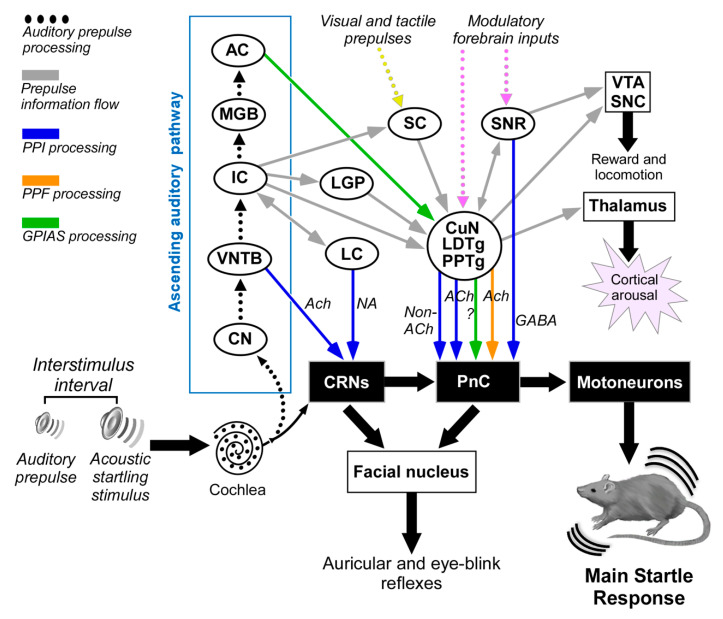Figure 2.
Multiple neuronal pathways for sensorimotor gating processes modulating the acoustic startle reflex in experimental animals. The auditory prepulse is processed through specific auditory nuclei in a serial hierarchical fashion and is then transmitted to many structures outside the auditory pathway. The auditory prepulse inhibition (depicted in blue arrows) involves the participation of VNTB-to-CRN projections that mediate fast acoustic inputs to reduce CRN responses at short interstimulus intervals, while the IC, SC, CuN, laterodorsal tegmental nucleus (LDTg), PPTg to PnC pathway mediates a slower pathway for auditory prepulse inhibition at long interstimulus intervals. Acetylcholine and other non-cholinergic neurotransmitters exert modulation on the CRNs and PnC. Notice that the IC might also bypass the SC via direct projections to PPTg. Furthermore, the GABAergic projection from the SNR to the PnC might be part of the PPI mediating pathway. The prepulse facilitation (depicted in orange arrow) implies cholinergic projections from PPTg to PnC. The gap-induced inhibition of the acoustic startle (GPIAS, depicted in green) involves the participation of the primary auditory cortex and PPTg. Tactile and visual prepulses are integrated into the PPI mediation circuit by some structures processing multi-modal cues. This connection diagram summarized data from the following studies: [85,93,104,105,106,110,111]. Abbreviations: AC: auditory cortex; CN: cochlear nucleus; CRNs: cochlear root neurons; CuN: cuneiform nucleus; IC: inferior colliculus; LC: locus coeruleus; LDTg: laterodorsal tegmental nucleus; LGP: lateral globus pallidus; MGB: medial geniculate body; PnC: caudal pontine reticular nucleus; PPTg: pedunculopontine tegmental nucleus; SC: superior colliculus; SNC: substantia nigra, pars compacta; SNR: substantia nigra, pars reticulata; VNTB: ventral nucleus of the trapezoid body; VTA: ventral tegmental area.

